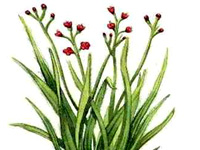Palmarosa (Cymbopogon martini)

Introduction
Cymbopogon martini belongs to family Poaceae that yields important oil having good export demand.
Cultivation Parameter:
Soil & climate:
It requires wide range of soils, which are free from water logging, but a well-drained loamy soil is reported to be best. It needs an annual rainfall of 150 cm.
Land preparation:
First the land is ploughed for 2-3times and per acre 7-10 gobar or compost is given for land preparation. After that 200-300gms of neem barks are spread to avoid termites in the field or BHC powder is also given to the field. Now it is ready for seed sowing. But if transplantation is done then in intial stages, diurane 400gms in 600 litres is mixed or simazin 500 Gms or oxiflurophen 200 Gms is put in every acres of land.
Propagation:
It is best raised by transplanting the nursery-raised seedlings or by root cuttings of healthy plants.
- Transplanting Nursery raised seedlings: Nursery beds are well prepared in May. Raised beds are preferably as the seeds are not washed off by irrigation. The seeds are sown in lines, 15-20 cm apart. About 2.5 kg seeds are adequate to give seedlings for planting a hectare.
Germination starts in 2 weeks. These seedlings are transplanted in June and July. The healthy and established seedlings which are 15 cm high are planted 60 cm apart.
- Root cutting: Plants giving good yield and high quality oil are to be used. However rate of establishment of root slips is very poor as compared to nursery transplants. Slips can be planted in June-July or rainy seasons.
Spacing:
Healthy and established seedlings, which are about 15 cm height are carefully removed from the nursery and transplanted in rows at 60x60 cm distance.
Irrigation:
During the rainless days the crop is irrigated at 8-10 days interval for better growth and recovery of essential oils.
Weeding:
Regular weeding especially of the weeds which imparts their own odour is necessary to maintain the quality of oil.
Manuring:
As the grass is a perennial, it is necessary to replenish the soil with rich soils. Manuring may not be required for the first two years. By manuring rich soils, the vegetative growth is increased and oil content is reduced. In deficient soils, a mixture consisting of 20 kg N, 50 kg P2O5 and 40 kg K2O per hectare.
About 40 kg N /ha is applied in the three split doses during the growing season. The mixture of NPK should be repeated at the time of appearance of fresh leaves each year.
Pests and diseases:
No serious diseases and insects pest has been reported under this crop.
Harvesting:
The grass is harvested when it is of about 4 months age and in full bloom stage. It is cut at a height of 5-8 cm from the ground level and the whole plant is used for distillation. Generally two cuttings are made during first year planting. From 2nd year onwards 3 cuttings are possible. Palmarosa plant remains productive for about 4 years. The cut grass is allowed to wilt in shade for about 24-48 hours before distillation.
Yield:
The oil content is low in the first year and it increases with the age. On an average the oil content may range from 0.2-0.3 %. An oil yield of about 220-250 kg per hectare may obtained from second year onwards.
Economics:
Yield per hectare after 5 years - 50kg oil/hec
Sale Price - Rs. 25000/- @ Rs. 500 per Kg oil for 50 kg
Expenditure - Rs. 6000/- per hectare
Net profit/hectare/year - Rs. 19000/-
Source:
- Cultivation of medicinal and aromatic crops by A.A.Farooqi and B.S.Sreeramu.
- Cultivation of medicinal plants by Dr. C.K.Kokate, Dr. A.S.Gokhle and Prof. S.B.Gokhle
|

